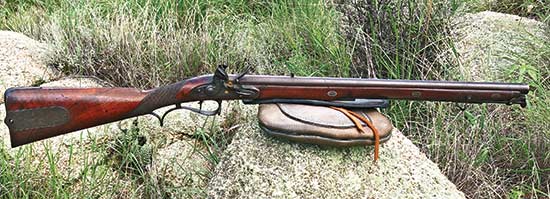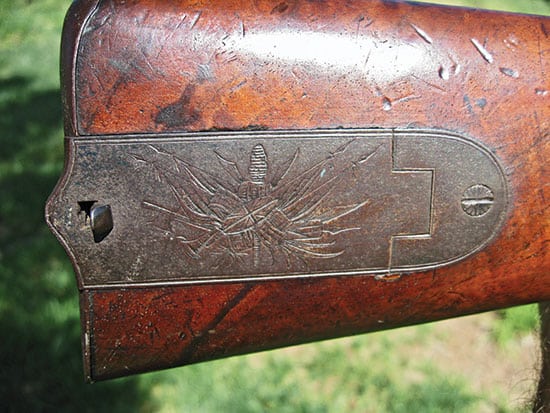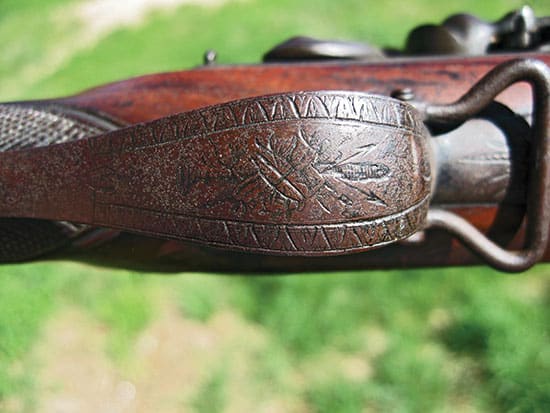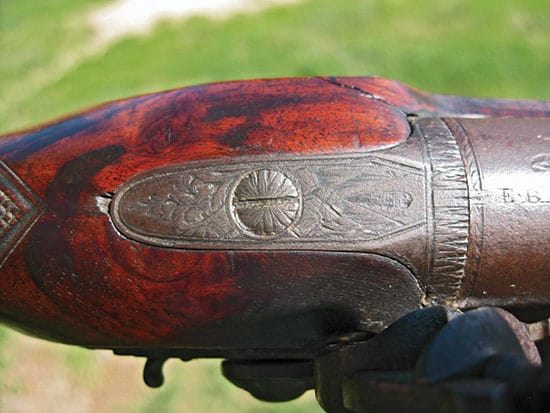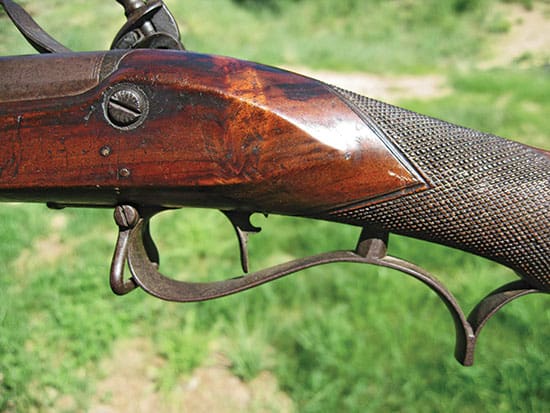An Officer’s Rifle
Found! A Sensational Napoleonic-Era Baker Carbine
Gun collecting is a lot like big game hunting. You search for a specific quarry, stalking through endless gun shows, gun shops, antique shops, pawn shops, flea markets, internet auction sites when suddenly your whole game is thrown off balance with the appearance of an even rarer trophy. It’s like going deer hunting and stumbling into a 600-pound black bear. A similar event happened to me recently.
I was cruising the racks of Jim Sharrah’s Frontier Gun Shop in Tucson, Arizona, when I spied an antique piece I had not seen before. It was a flintlock. It was short, light with a large bore and a captive ramrod. Looking more closely, it bore a gold touchhole and a maker’s mark struck in gold that reads “BAKER.” It shared most of the features of an English military Baker rifle or carbine, but the quality of workmanship and the lines exhibited in the gun were extraordinary. This was a mystery to be solved.
While Britain had incorporated rifles alongside smoothbore muskets in a variety of 18th century conflicts, they were primarily a hodgepodge of designs purchased openly on the Continent, particularly from Germany, nor was there a very clearly defined tactical doctrine for their deployment. The American Revolution had to have been somewhat of an eye-opener with the Hessians and their Jaeger rifles, the Colonists and Indians with their long rifles and even with the brief British experiment with the breech-loading Ferguson.
This changed in the late 18th century as old enemies like the French fielded organized skirmishers ahead of their infantry to obtain intelligence, snipe and otherwise harass and disrupt the enemy ranks. They were the special operations troops of the era. Britain rapidly undertook to outfit its own brand of specialized rifle units and in doing so, decided to make a standard rifle of their own.
Enter Ezekiel Baker, a London-based gunmaker specializing in barrels and locks, and a former apprentice to renowned gunmaker, Henry Nock. Baker was a known quantity in government circles, having had contracts from the government and the East India Company for smoothbore pistols and muskets. He also wrote a brief but informative book entitled, Remarks on Rifled Guns so I’ll let him tell his story.
“In 1800, the Government being about to raise a rifle regiment, a Committee of Field Officers was appointed by the Board of Ordnance to fix on the best kind of arms for their use, and several gunmakers were desired to send in specimens. There were barrels of French, German, Spanish, Dutch, American, and all nations, brought forward in competition: but mine beat them all, in a trial at Woolwich before the committee—the distance 300 yards. My barrel was two feet six inches, with a 20 to the pound bore ball (0.625 inch), rifled one quarter turn in the angle of the barrel; and so highly was it approved of, that I afterwards mounted it as a pattern for military use.”
Having won the barrel competition, Baker was tasked with designing a rifle. His earliest attempts proved too heavy, and too long to please Col. Coote Manningham, who was charged with raising the new rifle corps, the 95th Regiment of Foot. Accordingly, Manningham presented Baker with a Jaeger rifle to study.
The final Pattern 1800 Baker Infantry Rifle does indeed show Jaeger influence with its short 30-3/8-inch barrel, full-length walnut stock with cheekrest, brass furniture and patchbox, iron ramrod and brazed-on sword bayonet bar at the muzzle. A distinctive line of the Baker is the pistol grip formed by the triggerguard. Often ascribed to Baker, it is a pure Jaeger design.
The Baker barrel is 0.625-inch caliber rifled with 7 lands and a 1/4 turn rate-of-twist (1:120), said to minimize fouling and maximize accuracy. The Baker-toting British riflemen were supplied paper cartridges as well as loose balls and powder. The cartridges were used for skirmishing and rapid fire while loose powder and patched ball was used for sniping and precision shooting.
The diameter of the patched ball was 0.596-inch and the cartridge ball, 0.615-inch, and sometimes those figures are found reversed. The standard power charge ranged from 96 to 110 grains.
In 1803, Baker designed a cavalry carbine. In his own words, “In 1803, I tried a rifle-barrel for cavalry, twenty inches in length, before the same committee (of Field Officers as in 1800) at Woolwich, in competition with other makers; when a decided preference was given to mine, which I afterwards mounted as a pattern for the Tenth Regiment of Light Dragoons, under the command of His late Majesty George the Fourth, then Prince of Wales.”
And what does this tell us about the extraordinary Baker rifle sitting in the gun rack at the Frontier Gun Shop? The barrel is neither 30.5 inches as in the later infantry pattern rifles nor is it 20 inches as in the cavalry carbines, yet the barrel sports the captive ramrod of the cavalry carbine. The piece is mounted in what was once richly blued iron, not brass. Because of the quality of Baker’s workmanship and engraving, it is obviously not an issue piece but a “private purchase” arm.
The barrel is engraved “E. Baker. Rifle Gun Maker to his Royal Highness the Prince of Wales.” The Prince of Wales, who commanded the 10th Regiment of Light Dragoons and who encouraged Baker to design the 1803 cavalry carbine, emerges as Baker’s royal patron. In 1820, the Prince of Wales, who is now Prince Regent, would be crowned King George IV. Baker had a keen political sense!
To return to the question of what exactly is this Baker rifle resting in the Frontier Gun Shop, I turned to the world’s foremost expert, De Witt Bailey, Ph.D. and author of British Military Flintlock Rifles 1740-1840. Sharing photographs and email descriptions with Dr. Bailey, he responded:
“What you have is a high quality, commercial version of the Baker Rifled Cavalry Carbine first made for the Board of Ordnance in 1803 by the designer, Ezekiel Baker. Short of gold or silver inlay and gilded furniture, this is Baker at his best. It would have been made for either an officer of one of the British Army regiments whose men were equipped with the military version of the carbine, or for an officer of one of the many mounted regiments of Volunteers raised as a result of the Invasion Scare of 1803-4. The engraving on the iron furniture is typical for the time and circumstances. It would have been made prior to 1811 when Prince of Wale’s title changed to Prince Regent.”
And that’s not quite the end of the Baker story. Baker pattern infantry rifles and cavalry carbines continued in service on a worldwide basis until the late 1830s when it was gradually replaced by the Brunswick rifle. During its service life, American forces faced Baker-equipped riflemen throughout the War of 1812-15, culminating in Battle of New Orleans and even as late as 1836 in the hands of General Santa Anna’s troops at the Battle of the Alamo.
In closing, the best look of the Baker rifle in use is the former Sharpe’s TV series, based on the Bernard Cornwell novels now available in DVD, tracing a unit of the 95th Regiment during the Peninsular Campaign under Wellington. It’s a glorious overview of the rifles, uniforms, equipment and tactics of the Baker riflemen.
Further Reading
British Military Flintlock Rifles: 1740-1840, by DeWitt Bailey, ©2002, hardcover, 264 pages, 320 photos, 8.5×11 inches, $47.95, ISBN: 1-931464-30-0, Mowbray Publishing, 54 East School Street, Woonsocket, RI 02895, (800) 999-4697, www.gunandswordcollector.com
Remarks on Rifled Guns, by Ezekiel Baker. Available as a facsimile reprint through www.abebooks.com
Subscribe To GUNS Magazine
